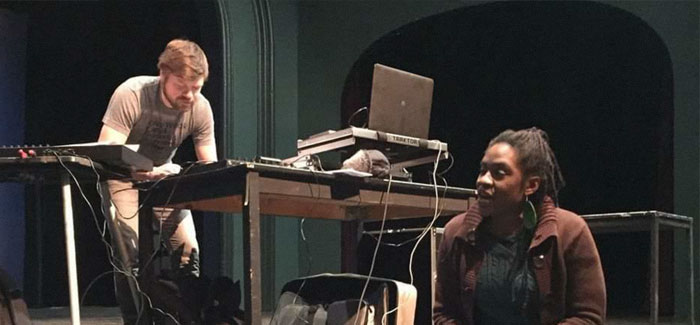
Company member and storyteller Amina Norman-Hawkins, rehearses for “Look Again: Stories of Rediscovering the Familiar” with DJ Mikhail “Misha” Fiksel, AB’01. (Photos courtesy 2nd Story)
Alumni-led storytelling collective focuses on sparking conversation.
It was a typical 2nd Story show, except it wasn’t.
The January performance at Hyde Park’s the Promontory was typical for the storytelling collective, says 2nd Story director of programming Jess Kadish, AB’11, in that four performers each told a story that related to a common theme. The storytellers, backed by a DJ and live band, took the stage to tell personal narratives about “rediscovering the familiar.” These ranged from a tale of falling back into old dating habits (and into the arms of former flames) to a story about returning to Marquette Park and the site of an unexpected confrontation with the Ku Klux Klan.
What made it different, explains sound designer and DJ Mikhail “Misha” Fiksel, AB’01, was the stage. In the past, 2nd Story’s events had been held mostly in smaller bars and coffee shops where the storytellers and musicians had been more integrated with the audience. Hosting an event with a designated stage, audience seating, and a “clearly defined direction of attention” was a new experience for the performance company, he says.
[[{"type":"media","view_mode":"media_original","fid":"2329","attributes":{"alt":"","class":"media-image","height":"293","typeof":"foaf:Image","width":"460"}}]]
Karla Estela Rivera performs during “Look Again: Stories of Rediscovering the Familiar” at the Promontory in Hyde Park. (Photos courtesy 2nd Story)
The company began as a casual dramatic reading series on the second floor of Webster’s Wine Bar in Chicago’s Logan Square neighborhood back in 2002. Since then, 2nd Story has evolved into a group of part-time administrators and company members who host storytelling events throughout the city. They now mix small-venue events with performances in larger spaces like the Promontory (about 250 people attended the January show).
The stories come from a variety of sources. After company leaders choose an overarching theme, the stories emerge from company members, from 2nd Story’s annual open submissions period, or from artists the company has worked with in the past.
For 2nd Story, a good story is one that leads to a second—one that resonates with audience members in a way that leads to conversations between stories or after the show. The most resonate stories share a significant, not just entertaining, moment, says executive artistic director Amanda Delheimer Dimond, AB’99, AM’99. “Why the story is important to the teller is the reason why the story is important to the audience or is important to the human experience,” she says. “And that is the beginning of the conversation—it opens a door as opposed to closing it.”
Many viewpoints and topics are presented at 2nd Story shows, including sensitive or potentially offensive material, as long as the resulting story works to create connections and community rather than divisions. Dimond recalls a story told a few years ago about a heterosexual man who inadvertently goes into a gay bar and is forced to confront prejudices he didn’t know he had. It was a story about homophobia, not a homophobic story, she says. What was engaging for the audience was the narrator sharing his realization and then exploring the ramifications. “The thing that is exciting or kind of imperative … is that there’s some inquiry happening, some curiosity, and not judgment, happening on the part of the narrator,” she says.
Ideally that inquiry and curiosity leads to some kind of personal change or growth, says Kadish. There’s a vulnerability in sharing a story that has had a transformative effect on the teller. But it’s also what inspires audience members to fill the space between stories with their own conversations and linger after the show, she says.
“[It creates] a real give-and-take … and a connection,” says Kadish, wherever the stories are told.
